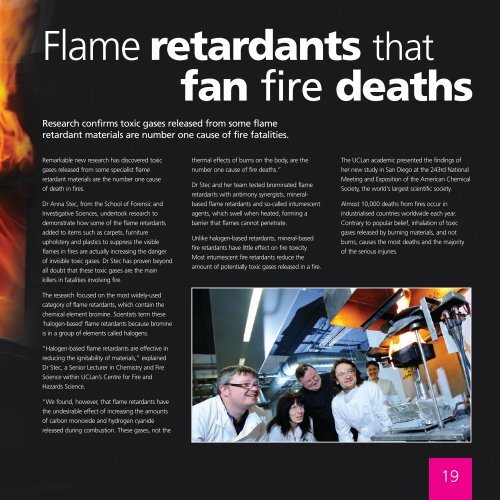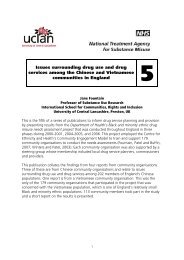Layout 2 - University of Central Lancashire
Layout 2 - University of Central Lancashire
Layout 2 - University of Central Lancashire
Create successful ePaper yourself
Turn your PDF publications into a flip-book with our unique Google optimized e-Paper software.
Flame retardants that<br />
fan fire deaths<br />
Research confirms toxic gases released from some flame<br />
retardant materials are number one cause <strong>of</strong> fire fatalities.<br />
Remarkable new research has discovered toxic<br />
gases released from some specialist flame<br />
retardant materials are the number one cause<br />
<strong>of</strong> death in fires.<br />
Dr Anna Stec, from the School <strong>of</strong> Forensic and<br />
Investigative Sciences, undertook research to<br />
demonstrate how some <strong>of</strong> the flame retardants<br />
added to items such as carpets, furniture<br />
upholstery and plastics to suppress the visible<br />
flames in fires are actually increasing the danger<br />
<strong>of</strong> invisible toxic gases. Dr Stec has proven beyond<br />
all doubt that these toxic gases are the main<br />
killers in fatalities involving fire.<br />
The research focused on the most widely-used<br />
category <strong>of</strong> flame retardants, which contain the<br />
chemical element bromine. Scientists term these<br />
‘halogen-based’ flame retardants because bromine<br />
is in a group <strong>of</strong> elements called halogens.<br />
“Halogen-based flame retardants are effective in<br />
reducing the ignitability <strong>of</strong> materials,” explained<br />
Dr Stec, a Senior Lecturer in Chemistry and Fire<br />
Science within UCLan’s Centre for Fire and<br />
Hazards Science.<br />
“We found, however, that flame retardants have<br />
the undesirable effect <strong>of</strong> increasing the amounts<br />
<strong>of</strong> carbon monoxide and hydrogen cyanide<br />
released during combustion. These gases, not the<br />
thermal effects <strong>of</strong> burns on the body, are the<br />
number one cause <strong>of</strong> fire deaths.”<br />
Dr Stec and her team tested brominated flame<br />
retardants with antimony synergists, mineralbased<br />
flame retardants and so-called intumescent<br />
agents, which swell when heated, forming a<br />
barrier that flames cannot penetrate.<br />
Unlike halogen-based retardants, mineral-based<br />
fire retardants have little effect on fire toxicity.<br />
Most intumescent fire retardants reduce the<br />
amount <strong>of</strong> potentially toxic gases released in a fire.<br />
The UCLan academic presented the findings <strong>of</strong><br />
her new study in San Diego at the 243rd National<br />
Meeting and Exposition <strong>of</strong> the American Chemical<br />
Society, the world's largest scientific society.<br />
Almost 10,000 deaths from fires occur in<br />
industrialised countries worldwide each year.<br />
Contrary to popular belief, inhalation <strong>of</strong> toxic<br />
gases released by burning materials, and not<br />
burns, causes the most deaths and the majority<br />
<strong>of</strong> the serious injuries.<br />
19
















